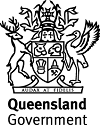Published Saturday, 12 April, 2008 at 12:02 AM

Minister for Sustainability, Climate Change and Innovation
The Honourable Andrew McNamara
“Extinct” Plant Species Found in Queensland
Two plant species thought to have been extinct since the late 1800s have been rediscovered in Far North Queensland.
Details of the two discoveries are included in the State of the Environment Queensland 2007 Report released today.
The State of the Environment Report – presented by more than 100 experts across government and academic institutions – contains the most comprehensive information on Queensland’s environment available.
Minister for Sustainability, Climate Change and Innovation, Andrew McNamara, said the two plants are:
• Rhaphidospora cavernarum - a large herb 0.5 to 1.5m high; flower white with purplish markings in the throat; and
• Teucrium ajugaceum (a native mint) - a semi-prostrate herb with trailing stems up to 20 cm tall; flowers pale mauve or white with mauve markings.
“It’s very exciting that both plants have been rediscovered more than a century after the last reported sighting,” Mr McNamara said.
“Rhaphidospora cavernarum was listed by the Environmental Protection Agency as Presumed Extinct and listed in the regulations of the Nature Conservation Act, as it had not been collected from Queensland since 1873.
“A number of more recent collections from eastern Cape York were identified as this species by staff from the State Herbarium of South Australia.
“The species has now been reclassified as Vulnerable, based on its currently known restricted geographic distribution on Cape York Peninsula between Cooktown and Lockhart River.
“Teucrium ajugaceum, which occurs in eucalypt woodland with a grassy understorey, was presumed extinct because the most recent collection was from Musgrave Telegraph Station on Cape York in 1891.
“Despite extensive survey on Cape York by EPA staff, the species was not rediscovered until 2004 in the vicinity of Musgrave Telegraph Station.
“The species was reclassified as Vulnerable, based on its restricted known habitat within approximately 120 km of the original collections at Musgrave Telegraph Station.”
Copies of the report’s key findings, the Queensland Government response and the full report are available at: www.epa.qld.gov.au/environmental_management/state_of_the_environment.
Media contact: Peter McCarthy 3336 8004
Details of the two discoveries are included in the State of the Environment Queensland 2007 Report released today.
The State of the Environment Report – presented by more than 100 experts across government and academic institutions – contains the most comprehensive information on Queensland’s environment available.
Minister for Sustainability, Climate Change and Innovation, Andrew McNamara, said the two plants are:
• Rhaphidospora cavernarum - a large herb 0.5 to 1.5m high; flower white with purplish markings in the throat; and
• Teucrium ajugaceum (a native mint) - a semi-prostrate herb with trailing stems up to 20 cm tall; flowers pale mauve or white with mauve markings.
“It’s very exciting that both plants have been rediscovered more than a century after the last reported sighting,” Mr McNamara said.
“Rhaphidospora cavernarum was listed by the Environmental Protection Agency as Presumed Extinct and listed in the regulations of the Nature Conservation Act, as it had not been collected from Queensland since 1873.
“A number of more recent collections from eastern Cape York were identified as this species by staff from the State Herbarium of South Australia.
“The species has now been reclassified as Vulnerable, based on its currently known restricted geographic distribution on Cape York Peninsula between Cooktown and Lockhart River.
“Teucrium ajugaceum, which occurs in eucalypt woodland with a grassy understorey, was presumed extinct because the most recent collection was from Musgrave Telegraph Station on Cape York in 1891.
“Despite extensive survey on Cape York by EPA staff, the species was not rediscovered until 2004 in the vicinity of Musgrave Telegraph Station.
“The species was reclassified as Vulnerable, based on its restricted known habitat within approximately 120 km of the original collections at Musgrave Telegraph Station.”
Copies of the report’s key findings, the Queensland Government response and the full report are available at: www.epa.qld.gov.au/environmental_management/state_of_the_environment.
Media contact: Peter McCarthy 3336 8004

